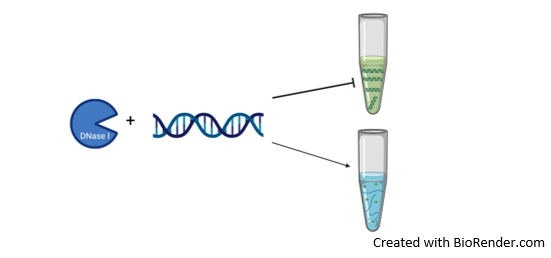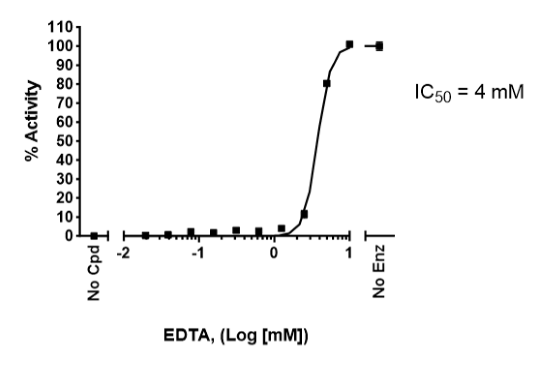2-Step DNase I Assay Kit
The 2-Step DNase I Assay Kit is a homogeneous fluorescent based assay kit designed to measure DNase I activity for screening and profiling applications. The assay kit comes in a convenient 96-well format, with enough purified recombinant DNase I, DNA substrate, GroovyGreen™ dye, assay buffer and co-factors for 100 enzyme reactions. The kit also contains EDTA as internal control.

Figure 1: 2-Step DNase I Assay Kit mechanism.
DNase I cleaves DNA molecules into nucleotides. The amount of nucleotide formed correlates directly with DNase I activity and can be quantified by the addition of a fluorescent dsDNA-binding dye which distinguishes dsDNA from free nucleotides. Since the dye emits fluorescence only when bound to the target dsDNA, the signal is inversely proportional to DNase I activity
Fluorescence plate reader capable of measurement at λex502/λem523 nm.
| Catalog # | Name | Amount | Storage |
| DNase I (Bovine)* | 100 U | -80°C | |
| Nicked DNA Substrate (20 ng/µl) |
1 µg | -80°C | |
| 10X DN-01 Assay Buffer 1 (Incomplete Buffer) | 2 x 300 µl | -80°C | |
| 0.5 M EDTA | 50 µl | 4°C | |
| 200x GroovyGreenTM Dye | 25 µl | -80°C | |
| 0.5 M MgCl2 | 30 µl | 4°C | |
| 1 M MnCl2 | 15 µl | 4°C | |
| 79685 | 96-well black microplate | 1 | Room Temp |
* The concentration of protein is lot-specific and will be indicated on the tube containing the protein.
DNase I, or deoxyribonuclease I, belongs to the DNase family of proteins. It is an endonuclease, and it can act on single- and double-stranded DNA (dsDNA), cleaving phosphodiester bonds located adjacent to pyrimidine nucleotides. DNase I is a commonly used tool in molecular biology, allowing degradation of DNA from RNA preparations, identification of protein binding sequences and preventing DNA related clumping in cell culture. It does not seem to have a preference for DNA bases, but it has higher sensitivity to minor grooves and the cleavage of purine-pyrimidine sequences. In the clinic, recombinant human DNase I has been used since 1993 in the treatment of patients with cystic fibrosis, by hydrolyzing the DNA present in the sputum of these patients. Its use in diseases where extracellular DNA is thought to play a role, such as chronic sinusitis and atelectasis, has also been evaluated. Interestingly, it may also have a potential application in SLE (systemic lupus erythematosus) by degrading DNA and preventing the formation of immune complexes. Deficiency in DNase can lead to anemia, cataracts and SLE. An understanding of its activity and inhibitors will provide useful insights into the mechanisms and therapies for extracellular DNA accumulation related diseases.
Lazarus R. and Wagener J., 2019, Pharmaceutical Biotechnology: 471-488.


